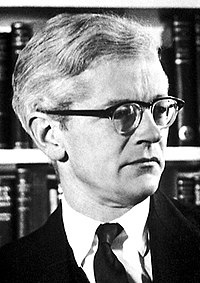John Kendrew | |
|---|---|
 | |
| Born | John Cowdery Kendrew 24 March 1917 Oxford, England |
| Died | 23 August 1997 (aged 80) Cambridge, England |
| Education | Clifton College |
| Alma mater | University of Cambridge |
| Known for | Haem-containing proteins |
| Awards |
|
| Scientific career | |
| Fields | Crystallography |
| Institutions | MRC Laboratory of Molecular Biology Peterhouse, Cambridge Royal Air Force |
| Thesis | X-ray studies of certain crystalline proteins : the crystal structure of foetal and adult sheep haemoglobins and of horse myoglobin (1949) |
| Academic advisors | Max Perutz |
| Doctoral students | |
| Other notable students | James D. Watson (postdoc)[2] |
| Military career | |
| Allegiance | |
| Service | |
| Years of service | 1941–1945 |
| Rank | Wing Commander (RAFVR) |
| Battles / wars | Second World War |
Sir John Cowdery Kendrew, CBE FRS[3] (24 March 1917 – 23 August 1997) was an English biochemist, crystallographer, and science administrator. Kendrew shared the 1962 Nobel Prize in Chemistry with Max Perutz, for their work at the Cavendish Laboratory to investigate the structure of haem-containing proteins.
- ^ Huxley, Hugh Esmor (1953). Investigations of biological structures by X-ray methods : the structure of muscle. lib.cam.ac.uk (PhD thesis). University of Cambridge. OCLC 885437514. EThOS uk.bl.ethos.604904.
- ^ a b c "John Kendrew academic genealogy". academictree.org.
- ^ Holmes, K. C. (2001). "Sir John Cowdery Kendrew. 24 March 1917 - 23 August 1997: Elected F.R.S. 1960". Biographical Memoirs of Fellows of the Royal Society. 47: 311–332. doi:10.1098/rsbm.2001.0018. hdl:11858/00-001M-0000-0028-EC77-7. PMID 15124647.